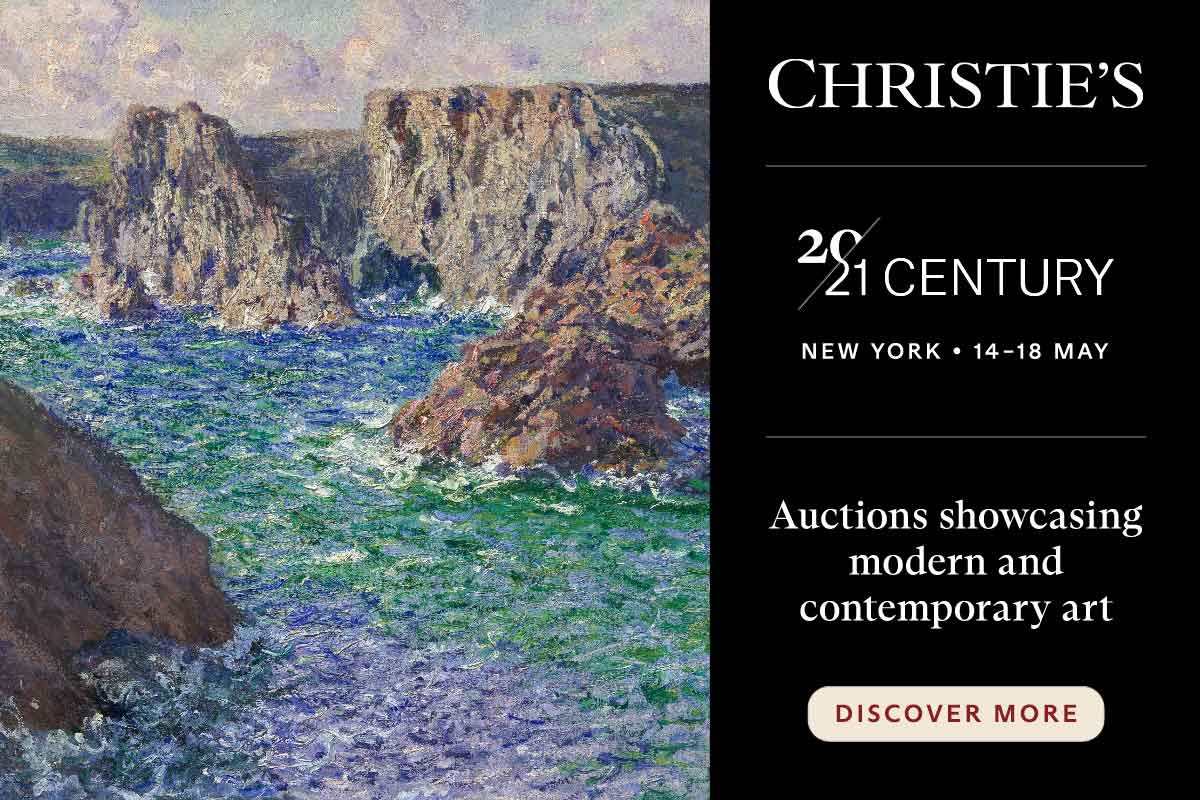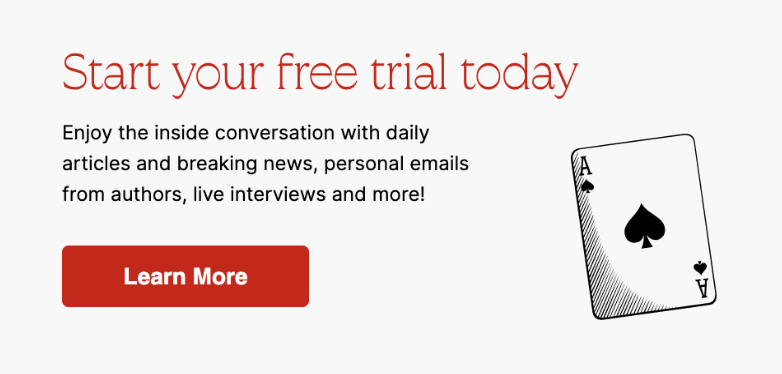 |
 |
|
|
|
WELCOME BACK!
|
|
You’re receiving a complimentary version of Wall Power as a welcome gift to new readers. Start a free 14-day trial to unlock unlimited access to Puck.
|
|
|
|
|
|
Welcome back to Wall Power. I’m Marion Maneker.
This week, the Appraiser’s Association is honoring the founder of Artnet, Hans Neuendorf. It’s the group’s 75th anniversary, so the annual fundraiser has been upgraded to a gala at Rockefeller Center’s Rainbow Room. As I’ll discuss, Artnet’s impact on the industry is undeniable. But… is it actually a good business?
We’ll get to that below the fold. But first…
|
|
A MESSAGE FROM OUR SPONSOR
|
 |
Coinciding with the 150th anniversary of the first Impressionist exhibition, Claude Monet’s Moulin de Limetz is a highlight of our 20th/21st Century Art auctions this season. Discover this and many other masterpieces at our Rockefeller Center galleries in New York.
|
|
|
- Congratulations to my colleague Lauren Sherman, whose Fashion People podcast debuted today and quickly rose to the top 10 in Apple’s Arts category. She’s coming for you, Fresh Air! If podcasts aren’t your thing, but you want to get the tutorial on the fashion business, try reading Line Sheet.
- LACMA’s eastward expansion: Michael Govan took to the Los Angeles Times to defend his museum's plans to collaborate with the still-forming Las Vegas Museum of Art, a large exhibition space hoping to open in 2028. Govan is taking flak from the Times for working with another city while his plans for more accessible satellite museums within sprawling L.A. have not emerged. The gist of the problem is that LACMA’s new museum, which won’t open until 2026, has less gallery space than the old one. To Govan, a larger museum with smaller galleries was a feature, not a bug. “I think that’s a very 20th century idea—to keep adding wings until you’re a million square feet on Fifth Avenue,” Govan said. “The 21st century idea is that you build infrastructure in other communities, as well as deep, long-term relationships. That’s my paradigm shift.”
At a recent conference held in Hudson Yards, MoMA’s Glenn Lowry declared the idea of obtaining more art as also “very 20th century.” Citing a range of concerns—including a fear that the populist political attacks from Congress aimed at universities might eventually fixate on museums—Lowry emphasized the importance of programming over the acquisition of objects. The problem, he reckoned, is that donors like to have their names on buildings, but programming is what builds a base of lasting support. “You have to think about the public,” Lowry concluded, “what do our publics want?” Managing the vanities of the trustees and the desires of the public is, of course, a director’s job—and may explain why filling the large number of directorships turning over soon, including Lowry’s own, is the next big challenge for the field.
|
|
You’re receiving a complimentary version of Wall Power at as a welcome gift to new readers. For full access to Puck, and to each of my colleagues, you can
subscribe here.
|
|
|
 |
| Artnet & The Price of Everything |
| Before Artnet, dealers and auction houses had a stranglehold on information. Then came Hans Neuendorf… and nothing has been the same since. |
|
|
|
| The other day, I asked a dealer about Artnet, the ubiquitous German-owned but U.S.-based art market media and data business, and the company’s prospects for the future. It wasn’t a leading question, but it was an increasingly relevant one. After all, the 35-year-old company’s guiding personality and founder, Hans Neuendorf, is now in his late 80s. After taking the company public on the German stock exchange, in 1999, the stock has fallen from €46 to €5.85 per share—an 87 percent drop.
Meanwhile, the company, which now has a market capitalization of around $37 million, has been beset by roiling turmoil surrounding what Hans pays himself in his emeritus existence (about $325,000) and what his son, now the C.E.O., earns (a little more). (Two of Neuendorf’s other children work as executives for Artnet, and a fourth did work for Artnet but left to become a Contemporary art specialist at Sotheby’s.) On the straightforward business side, there is frustration among users and animosity within the investor group over Artnet’s failure to modernize its janky tech.
The dissatisfaction could have material consequences. Since 2022, Rüdiger Weng, who owns another German art business and has surpassed Neuendorf as Artnet’s largest shareholder at nearly 30 percent, has been leading a campaign to remove Neuendorf. According to the letter Weng published at the time, “Artnet’s assets (brand name, website-traffic, data-protection, online auction-tool) are very valuable in today’s art market if all this is monetized by an experienced management team in the best interests of the company.” If Weng can ally with enough of the handful of other large stakeholders to get another 21 percent of the shares to vote with him, Hans will have lost his grip on the company. (Only a fraction of the outstanding shares trade publicly in Germany.) But Weng isn’t alone in this quest to oust Neuendorf. I spoke to a fund manager who has been sniffing around Artnet for more than a year, and he told me the company is on many boutique investment firms’ watch lists.
All of this is a long way of saying that I was surprised by the remarkably sanguine response from the art dealer. “Artnet isn’t a business,” he said, “it’s a brand. In fact, it’s a better brand than everyone but Sotheby’s, Christie’s, and Gagosian.”
Obviously, Artnet plays a central role in the market. The legions of art advisors who now shepherd collectors through galleries, fairs, and auction previews would be comparatively impotent without access to its database of auction prices. Artnet’s rise, however, hasn’t been easy, and much of the challenge seems to have come from Hans, himself.
In a six-part interview for his own publication on the occasion of Artnet’s 30th anniversary, former Artnet News editor Andrew Goldstein described Neuendorf as “stubborn, quixotic and deeply idealistic.” Before buying into Artnet at the beginning, Hans had established himself as a dealer in Hamburg in the 1960s by traveling to Paris to buy prints from legendary figures like Heinz Berggruen and Ileana Sonnabend. He was among the group of gallerists who created the world’s first art fair, Art Cologne, in 1967. Two years later, Ernst Beyeler would bring the idea to Basel when he founded Art Basel.
Twenty years later, Neuendorf stumbled into a group who were trying to catalog art sale prices. They started with the readily available auction prices, which they used to build a digital database and then began to fax reports to customers. When the original founders grew frustrated with the business, they allowed Hans to buy their shares. Eventually, he borrowed from acquaintances (including a Rothschild), the internet arrived, and Artnet was able to ditch the fax machines as Hans expanded his hustle. “In starting Artnet,” Goldstein wrote, “Neuendorf overcame an unceasing parade of crises and challenges, keeping the company going by selling artworks to fund operations and maintaining a conviction—he might call it naiveté—that success was always right around the corner.” |
|
A MESSAGE FROM OUR SPONSOR
|
 |
Coinciding with the 150th anniversary of the first Impressionist exhibition, Claude Monet’s La Roche Guibel, Port-Domois is included in our 20th/21st Century Art auctions this season. Discover this and many other masterpieces at our Rockefeller Center galleries in New York.
|
|
|
|
|
| Thirty-five years in, success is still just beyond Artnet’s reach. The good news is that there is no shortage of potential investors or acquirers for a data-first business that made $26 million in revenue in 2022. The Neuendorfs may be running it a bit like a cottage industry, but private equity executives feast on these sort of paint-by-numbers opportunities—strip down the business, replace management, cut costs, and then flip—especially in recurring revenue companies that rely on subscriptions.
In many ways, Artnet’s shortcomings reflect its origins and the eccentricities of the art world. When the company was founded, in 1989, the art market relied on a combination of a telephone book-like listing of prices and the dealer’s own reference library of auction catalogs. Pricing a work involved cross-referencing the prices in the big book against the images, provenance, exhibition history, and other details stored in the catalogs. A good dealer attended all of the auctions in their area of expertise.
Even in the 1990s, auction houses primarily acted as wholesale operations for art dealers. The dealers examined the works before the sale, taking note of the quality of the image and condition of the work through close personal inspection. During the bidding, dealers scribbled their own notes in their catalogs, memorializing bidding increments, the number of different bidders and the names of underbidders. That last bit of information, the underbidder, was among the most valuable leads.
The quality of the information a dealer had was entirely dependent upon that dealer’s observational skills and attention span. Doze off during an auction, daydream, or get too involved in gossiping with your peers, you might miss that one key bit of information that could make your year. Artnet didn’t have then, nor does it have now, the ability to upload that rich source of information from the dealer’s experience. But it could copy down the auction prices easily.
“I remember being quite upset,” said Michael Findlay, now a director at Acquavella gallery, who worked at Christie’s in the 1990s, “when he was inputting information from our catalogs so he could sell it back to us.” Like many dealers and specialists who view pricing as more of an art than a science, Artnet’s database is only the beginning of what one needs to consider to arrive at a price. “It’s no more and no less than a compendium,” Findlay warned, before adding that all pricing information—but especially the almost random sliver of the market represented by auction prices—requires context, analysis, and interpretation. “It’s very raw data,” he explained. “It needs to be interpreted with some knowledge of the circumstances.”
Ed Dolman, who became C.E.O. at Christie’s in 1999 and now leads Phillips, remembered the same resistance to Artnet that riled Findlay. “It was our competitive advantage,” Dolman said, referring to the data. “Setting estimates and reserves was a lot easier when you knew the prices better than anyone else.” But it soon became apparent to Dolman that access to prices increased buyer confidence, and that Artnet was important for bringing in new clients, especially to Contemporary art. As most specialists in the industry will tell you, Asian collectors come in having done their homework on everything but especially prices.
Former Sotheby’s C.E.O. Bill Ruprecht didn’t feel the same way about price transparency. He proposed to Neuendorf that the house provide access to Artnet’s data on all its lots. In Ruprecht’s experience, Artnet is a tool that experts use internally but buyers are relatively indifferent to. “It’s a professional tool,” Ruprecht argued, “not a consumer tool.” That’s because buying art isn’t a rational act, as far as he can see. “I don’t think much art is getting bought because it is good value,” he continued. “It’s emotional.”
It may be an emotional purchase, but knowing the prices soothes a lot of nerves. “It’s the greatest gift to the art market,” said Gagosian chief operating officer Andrew Fabricant. “But, also, everyone is lazy. They don’t do their own research.” |
|
|
|
|
| The other problem is that Artnet’s database, its core product, hasn’t really changed in 30 years. Instead of building out the core product, Artnet pursued a variety of other quixotic and adjacent businesses. For years, the tiny online information service tried to run an online auction house, which Neuendorf seemed to believe would someday supplant Sotheby’s and Christie’s. It didn’t work. Neuendorf was able to find a lane in news, however. Ten years ago, a group of refugees from Louise Blouin’s Artinfo.com, led by Ben Genocchio, arrived at Artnet with a turnkey plan for building an art news operation. “He promised me the moon,” Neuendorf recalled in 2019. “He said the total cost of the whole thing, including staff, would be $700,000 a year, and we would be able to quickly bring that money in through advertising. Obviously, none of this was true, but that’s how it started.”
In some ways this was admirable. Neuendorf took the long view and subsidized news (as he did with auctions) until it finally broke through. In 2022, Artnet’s media operation brought in more than $9 million between advertising and subscriptions. In a field starved for coverage online, Artnet News has the most traffic and is packed with luxury ads from firms like Chanel, Van Cleef, and Hermès. (Here’s where I say that I used to work at a rival art news organization where I was responsible for thinking through how to replicate Artnet’s success with luxury advertisers.) That $9 million was a 37.5 percent jump from the year before. Yet the contribution margin—the revenue in excess of costs that can be used to pay overhead like executive salaries—rose less than 3 percent. From 2021 to 2022, “contribution margin II,” as Artnet’s annual report styles it, rose from just under 20 percent to just over 22 percent. Whatever extra money Artnet was making from its advertising bonanza was getting eaten up by additional costs.
Even though Neuendorf has only been a minority owner of Artnet since the I.P.O. in 1999, he’s had the support of some of his original investors, who have blocked the many attempts to acquire the company. That has begun to change, however. Despite all the natural investor interest in the business—the brand, the data, the tools, as Weng noted in his letter—Artnet’s total addressable market isn’t entirely clear. Rivals who have replicated much of Artnet’s database and improved upon its interface and analytics haven’t had a glide path to growth. That may be the moat of Artnet’s brand, or it might be that Artnet serves the art community well enough. Either way, as Hans Neuendorf approaches his 90th year, the success of Artnet remains elusive, and just around the corner. |
|
|
|
|
|
| FOUR STORIES WE’RE TALKING ABOUT |
|
|
|
|
|
|
|
 |
|
|
|
Need help? Review our FAQs
page or contact
us for assistance. For brand partnerships, email ads@puck.news.
|
|
You received this email because you signed up to receive emails from Puck, or as part of your Puck account associated with . To stop receiving this newsletter and/or manage all your email preferences, click here.
|
|
Puck is published by Heat Media LLC. 227 W 17th St New York, NY 10011.
|
|
|
|











